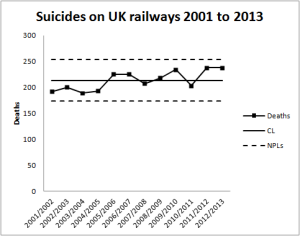11. Part B. Eliminate numerical goals for management.
 A supposed corollary to the elimination of numerical quotas for the workforce.
A supposed corollary to the elimination of numerical quotas for the workforce.
This topic seems to form a very large part of what passes for exploration and development of Deming’s ideas in the present day. It gets tied in to criticisms of remuneration practices and annual appraisal, and target-setting in general (management by objectives). It seems to me that interest flows principally from a community who have some passionately held emotional attitudes to these issues. Advocates are enthusiastic to advance the views of theorists like Alfie Kohn who deny, in terms, the effectiveness of traditional incentives. It is sad that those attitudes stifle analytical debate. I fear that the problem started with Deming himself.
Deming’s detailed arguments are set out in Out of the Crisis (at pp75-76). There are two principle reasoned objections.
- Managers will seek empty justification from the most convenient executive time series to hand.
- Surely, if we can improve now, we would have done so previously, so managers will fall back on (1).
The executive time series
I’ve used the time series below in some other blogs (here in 2013 and here in 2012). It represents the anual number of suicides on UK railways. This is just the data up to 2013.

The process behaviour chart shows a stable system of trouble. There is variation from year to year but no significant (sic) pattern. There is noise but no signal. There is an average of just over 200 fatalities, varying irregularly between around 175 and 250. Sadly, as I have discussed in earlier blogs, simply selecting a pair of observations enables a polemicist to advance any theory they choose.
In Railway Suicides in the UK: risk factors and prevention strategies, Kamaldeep Bhui and Jason Chalangary of the Wolfson Institute of Preventive Medicine, and Edgar Jones of the Institute of Psychiatry, King’s College, London quoted the Rail Safety and Standards Board (RSSB) in the following two assertions.
- Suicides rose from 192 in 2001-02 to a peak 233 in 2009-10; and
- The total fell from 233 to 208 in 2010-11 because of actions taken.
Each of these points is what Don Wheeler calls an executive time series. Selective attention, or inattention, on just two numbers from a sequence of irregular variation can be used to justify any theory. Deming feared such behaviour could be perverted to justify satisfaction of any goal. Of course, the process behaviour chart, nowhere more strongly advocated than by Deming himself in Out of the Crisis, is the robust defence against such deceptions. Diligent criticism of historical data by means of process behaviour charts is exactly what is needed to improve the business and exactly what guards against success-oriented interpretations.
Wishful thinking, and the more subtle cognitive biases studied by Daniel Kahneman and others, will always assist us in finding support for our position somewhere in the data. Process behaviour charts keep us objective.
If not now, when?
If I am not for myself, then who will be for me?
And when I am for myself, then what am “I”?
And if not now, when?
Deming criticises managerial targets on the grounds that, were the means of achieving the target known, it would already have been achieved and, further, that without having the means efforts are futile at best. It’s important to remember that Deming is not here, I think, talking about efforts to stabilise a business process. Deming is talking about working to improve an already stable, but incapable, process.
There are trite reasons why a target might legitimately be mandated where it has not been historically realised. External market conditions change. A manager might unremarkably be instructed to “Make 20% more of product X and 40% less of product Y“. That plays in to the broader picture of targets’ role in co-ordinating the parts of a system, internal to the organisation of more widely. It may be a straightforward matter to change the output of a well-understood, stable system by an adjustment of the inputs.
Deming says:
If you have a stable system, then there is no use to specify a goal. You will get whatever the system will deliver.
But it is the manager’s job to work on a stable system to improve its capability (Out of the Crisis at pp321-322). That requires capital and a plan. It involves a target because the target captures the consensus of the whole system as to what is required, how much to spend, what the new system looks like to its customer. Simply settling for the existing process, being managed through systematic productivity to do its best, is exactly what Deming criticises at his Point 1 (Constancy of purpose for improvement).
Numerical goals are essential
… a manager is an information channel of decidedly limited capacity.
Kenneth Arrow
Essays in the Theory of Risk-Bearing
Deming’s followers have, to some extent, conceded those criticisms. They say that it is only arbitrary targets that are deprecated and not the legitimate Voice of the Customer/ Voice of the Business. But I think they make a distinction without a difference through the weasel words “arbitrary” and “legitimate”. Deming himself was content to allow managerial targets relating to two categories of existential risk.
- Targets that guarantee survival levels of cash flow for the business; and
- Occupational exposure limits (OELs) for toxins.
However, those two examples are not of any qualitatively different type from the “Increase sales by 10%” that he condemns. Certainly back when Deming was writing Out of the Crisis most OELs were based on LD50 studies, a methodology that I am sure Deming would have been the first to criticise.
Properly defined targets are essential to business survival as they are one of the principal means by which the integrated function of the whole system is communicated. If my factory is producing more than I can sell, I will not work on increasing capacity until somebody promises me that there is a plan to improve sales. And I need to know the target of the sales plan to know where to aim with plant capacity. It is no good just to say “Make as much as you can. Sell as much as you can.” That is to guarantee discoordination and inefficiency. It is unsurprising that Deming’s thinking has found so little real world implementation when he seeks to deprive managers of one of the principle tools of managing.
Targets are dangerous
I have previously blogged about what is needed to implement effective targets. An ill judged target can induce perverse incentives. These can be catastrophic for an organisation, particularly one where the rigorous criticism of historical data is absent.

I don’t think this deconstruction is of the same quality / depth as some of your others. A key aspect that you touch on too little is the managers’ responsibilities to either provide the ‘by what method’ or to lead or significantly support the work to determine the ‘by what method’. The important message is that managers can’t simply throw lots of targets around the place as a means of ‘motivating’ their staff to achieve more. This often leads to staff competing with each other to achieve their often contradictory targets.
Also the ‘by what method’ must be based on understanding the system and its current performance so that the system is redesigned to achieve the targets.
It is important to have improvement aims, perhaps even necessities, but the way to manage these well does not simply involve handing round the targets. It needs thoughtful leadership and this has been and is still so often lacking.
Terry, many thanks for the comment. I agree. “Targets are dangerous”. Deming sees that as a reason to “eliminate” them. I advocate educated management of the risks. The problems you identify, and more, will be identified by rigorous risk assessment supported by behavioural economics.
I increasingly think that behavioural economics is what Deming was looking for to put in the “psychology” box.
I think you are confusing different things here. The targets which don’t work are for example “Reduce railway suicides to 150 per year” or in my world “Treat every patient within 4 hours”. Using the word “target” when deciding how much of a product to produce confuses the matter. A good operational system allows feedback between demand and production to produce the right amount. That may be a number which says “370 units needed today”, so that is a legitimate figure which if exceeded is overproduction, if undershot is missed sales.
In the NHS, by the way, we are burdened not only by arbitrary and always wrong targets concerning quality and service, but also the absence of any coupling between demand and supply, eg “delivery 7 appointments per 1000 patients per week”, which is too few in some GP practices and too many in others.
How are ‘properly defined’ targets defined? All numerical targets are arbitrary – I’m not aware of any credible method for setting a numerical target. Whether a process is stable or otherwise; whether system adjustments are made which improve performance and care is taken to try and mitigate behavioural dysfunction, the bottom line is that the target ignores variation, so is illegitimate by design.
I agree that targets are unwise. There is one sense in which I think the idea of (but not actual) targets can be useful and that is in setting the scope.
If we want to find an improvement that is immense (versus small continual improvement) that can set the expectation of how we approach improvement, including an understanding that we are going to have to really make big changes in how things are done.
I have written more about this, here:
http://curiouscat.com/management/deming/management_by_target
Basically I don’t see that scoping “target” as really a target but it is similar so if you want to see it that way, then in that sense I can see a “target” as useful.
John, Guilfoyle, Harry – Many thanks for the comments. I think we can all agree that, “An ill judged target can induce perverse incentives. These can be catastrophic for an organisation, particularly one where the rigorous criticism of historical data is absent.” Rigorous criticism of historical data is the key.